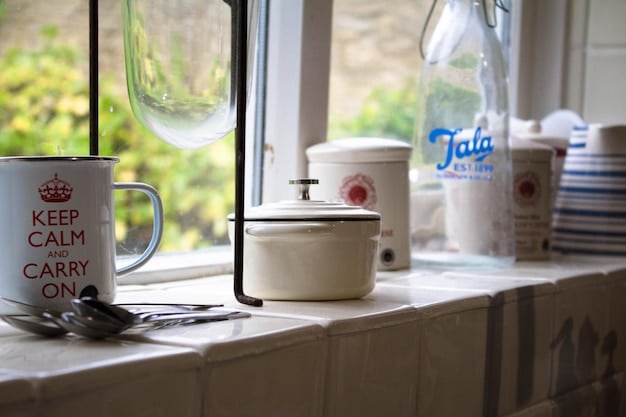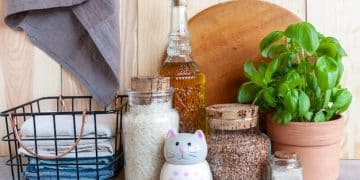Eco-Friendly Cleaning Products: Your Guide to a Non-Toxic Home

Eco-friendly cleaning products offer a safer and healthier alternative to conventional cleaners, reducing exposure to harmful chemicals and minimizing environmental impact while effectively cleaning your home.
Making your home sparkling clean doesn’t have to come at the expense of your health or the planet’s. Discover the world of eco-friendly cleaning products and create a healthier, more sustainable living space.
Why Choose Eco-Friendly Cleaning Products?
Switching to eco-friendly cleaning products is a simple yet impactful change you can make for a healthier home and a healthier planet.
Traditional cleaning products often contain harsh chemicals that can be harmful to your health and the environment. These chemicals can contribute to indoor air pollution, trigger allergies and asthma, and even have more serious long-term health effects. They also pollute our waterways when they go down the drain.
Healthier Home Environment
Eco-friendly cleaning products are typically made with plant-based ingredients and avoid harsh chemicals like phthalates, parabens, and synthetic fragrances. This means less exposure to toxins for you, your family, and your pets.
Reduced Environmental Impact
Eco-friendly products are often biodegradable and packaged in recycled or recyclable materials, reducing the amount of waste that ends up in landfills. They also minimize the release of harmful chemicals into the environment, protecting our water and air quality.
- Reduced risk of allergies and asthma triggers.
- Lower exposure to potentially harmful chemicals.
- Better for the environment due to biodegradable ingredients and sustainable packaging.
By choosing eco-friendly cleaning products, you’re making a conscious decision to protect your health and the environment. This is a small change that can have a big impact.
Understanding Labels and Certifications
Navigating the world of eco-friendly cleaning products can be confusing. Understanding labels and certifications can help you make informed choices and ensure that you are truly buying a product that is environmentally friendly.
Many products claim to be “natural” or “eco-friendly,” but these terms are not always regulated. Looking for third-party certifications is a good way to verify the product’s environmental claims.

Key Certifications to Look For
Here are some of the most common and reliable certifications to look for on eco-friendly cleaning products:
- EPA Safer Choice: This certification means that the product has been evaluated by the EPA and meets specific criteria for human health and environmental safety.
- Green Seal: Green Seal certification indicates that the product has been tested and meets rigorous environmental and performance standards.
- EcoLogo (now UL ECOLOGO): This certification signifies that the product has undergone testing to verify its reduced environmental impact.
Decoding Ingredient Lists
In addition to looking for certifications, it’s important to read the ingredient lists on cleaning products. Be wary of vague terms like “fragrance,” which can hide a cocktail of harmful chemicals. Look for products that clearly list all ingredients and avoid those with known toxins like chlorine bleach, ammonia, and phosphates.
By taking the time to understand labels and certifications, you can be confident that you are choosing cleaning products that are truly eco-friendly and safe for your home and family.
DIY Eco-Friendly Cleaning Solutions
One of the most cost-effective and eco-friendly ways to clean your home is to make your own cleaning solutions using simple ingredients you probably already have in your pantry.
DIY cleaning solutions are not only better for the environment, but they can also be gentler on your skin and save you money. Plus, you can customize them to suit your specific cleaning needs.
Basic Ingredients for DIY Cleaning
Here are some essential ingredients for making your own eco-friendly cleaners:
- White Vinegar: A natural disinfectant and deodorizer.
- Baking Soda: An abrasive cleaner and deodorizer.
- Lemon Juice: A natural disinfectant and degreaser.
Simple DIY Recipes
Here are a couple of easy recipes to get you started:
- All-Purpose Cleaner: Mix equal parts white vinegar and water in a spray bottle. Add a few drops of essential oils for fragrance, if desired.
- Oven Cleaner: Make a paste of baking soda and water. Spread the paste inside your oven and let it sit overnight. In the morning, scrub the oven clean.
Experiment with different ingredients and recipes to find what works best for you. With a little creativity, you can create a whole arsenal of eco-friendly cleaning solutions.
Top Eco-Friendly Cleaning Brands
If DIY isn’t your thing, there are plenty of fantastic eco-friendly cleaning brands on the market.
These brands are committed to using sustainable ingredients, eco-friendly packaging, and ethical manufacturing practices. Supporting these companies helps to promote a more sustainable cleaning industry.

Recommended Brands
Here are a few top eco-friendly cleaning brands to check out:
- Method: Known for their stylish packaging and plant-based formulas.
- Mrs. Meyer’s Clean Day: Offers a wide range of scented cleaning products made with essential oils and plant-derived ingredients.
- Blueland: Sells cleaning tablets that you dissolve in water, reducing plastic waste.
Factors to Consider When Choosing a Brand
When choosing an eco-friendly cleaning brand, consider the following factors:
- Ingredients: Look for brands that use plant-based ingredients and avoid harsh chemicals.
- Packaging: Choose brands that use recycled or recyclable packaging.
- Ethics: Support brands that are committed to ethical manufacturing practices.
By researching different brands and choosing those that align with your values, you can support a more sustainable cleaning industry while keeping your home clean and healthy.
Making the Switch: A Gradual Approach
Switching to eco-friendly cleaning products doesn’t have to happen overnight. A gradual approach can make the transition easier and more sustainable.
Start by replacing one or two of your most frequently used cleaning products with eco-friendly alternatives. As you run out of your old products, gradually replace them with eco-friendly options. This will help you minimize waste and spread out the cost of switching.
Tips for a Smooth Transition
Here are a few tips to help you make the switch to eco-friendly cleaning products:
- Start Small: Begin by replacing the products you use most often.
- Read Reviews: See what other people have to say about different eco-friendly products.
- Be Patient: It may take some trial and error to find the products that work best for you.
Addressing Common Concerns
Some people worry that eco-friendly cleaning products aren’t as effective as traditional cleaners. However, many eco-friendly products are just as effective, if not more so, than their conventional counterparts. Look for products with good reviews and don’t be afraid to experiment.
By taking a gradual approach and addressing any concerns along the way, you can successfully make the switch to eco-friendly cleaning products and enjoy a healthier, more sustainable home.
The Impact of Eco-Friendly Cleaning on Indoor Air Quality
One of the most significant benefits of switching to eco-friendly cleaning products is the improvement in your home’s indoor air quality.
Traditional cleaning products often release volatile organic compounds (VOCs), which can contribute to indoor air pollution and have negative health effects. Eco-friendly cleaning products, on the other hand, are typically made with low-VOC or VOC-free ingredients, minimizing their impact on indoor air quality.
Understanding VOCs
VOCs are chemicals that evaporate at room temperature and can be found in many household products, including cleaning supplies, paints, and air fresheners. Exposure to VOCs can cause a variety of health problems, including headaches, dizziness, and respiratory irritation.
The Benefits of Low-VOC Cleaners
By choosing low-VOC or VOC-free cleaning products, you can significantly reduce your exposure to these harmful chemicals and improve the air quality in your home. This is especially important for people with asthma, allergies, or other respiratory conditions.
- Reduced exposure to harmful VOCs.
- Improved indoor air quality.
- Better health for you and your family.
Switching to eco-friendly cleaning products is a simple way to create a healthier indoor environment for yourself and your loved ones. A breath of fresh air, free from harmful chemicals, is a significant benefit you’ll notice right away.
| Key Point | Brief Description |
|---|---|
| 🌿 Healthier Home | Reduces exposure to harmful chemicals found in conventional cleaners. |
| 🌎 Eco-Friendly Impact | Biodegradable ingredients and sustainable packaging minimize environmental harm. |
| 💰 Cost-Effective DIY | Create your own cleaners with ingredients like vinegar, baking soda, and lemon. |
| ✅ Certifications | Look for EPA Safer Choice, Green Seal, and UL ECOLOGO logos for verified eco-friendliness. |
FAQ
▼
Yes, many eco-friendly cleaning products are just as effective as conventional cleaners. Look for products with good reviews and certifications to ensure they meet performance standards.
▼
Common ingredients include white vinegar, baking soda, lemon juice, essential oils, and plant-derived surfactants. These ingredients are natural, non-toxic, and effective for cleaning.
▼
You can easily make your own cleaners by mixing ingredients like vinegar and water for an all-purpose cleaner, or baking soda and water for scrubbing. There are many DIY recipes online!
▼
Look for certifications such as EPA Safer Choice, Green Seal, and UL ECOLOGO. These certifications indicate that the products have been tested and meet specific environmental standards.
▼
Some eco-friendly products may be slightly more expensive, but DIY cleaning can be very cost-effective. Making your own cleaners helps reduce costs and is more sustainable.
Conclusion
Switching to eco-friendly cleaning products is a beneficial step towards a healthier home and planet. Whether you choose store-bought brands or DIY solutions, you’re making a positive impact by reducing chemical exposure and minimizing environmental harm. Embrace the change and enjoy the benefits of a cleaner, greener lifestyle.





